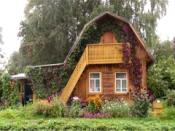Search
Login
Recommended
We make ventilation of the basement or cellar of a country house, various schemes of the device and their features
A country house without a basement or a cellar cannot be full-fledged, because no one will refuse additional space for storing things, vegetables and fruits, and possibly a device in the basement or basement of a sports hall, garage or workshop. But in order for the basement premises to allow all this to be done, it must be comfortable: dry and warm, moreover, at any time of the year and weather. It can be made so with the help of a proper ventilation device. And about how to do this, read our article.
Content
- Ventilation what is it
- Ventilation: types video
- Basement ventilation in a private house
- DIY basement ventilation video
Ventilation what is it
Ventilation - (from lat. ventilatio airing), a system of pipes, shafts and holes that provide movement, mixing of air masses with the subsequent removal of exhaust air from the room, as well as electrical devices contributing to this.
Properly organized ventilation ensures a comfortable stay in the house due to the durability of the building and the interior decoration of the house (after all, they will not be damaged by excessive humidity, fungus and bacteria) and the health of people breathing fresh, cleaner air is much stronger.
Ventilation: types
Exist:
-forced ventilation, provides air from the street (by fans or through the natural openings of windows, doors),
-exhaust ventilationprovides removal of exhaust air from the room (by fans, through ventilation shafts, air ducts)
-supply and exhaust ventilation, provides optimal movement of air and ventilation.
All types of ventilation systems can be both natural and artificial, forced:
-natural, which does not require special technical equipment and engineering calculations, ventilation: occurs through the natural movement of air through windows, doors and ducts. Air enters, moves and is removed from the room due to the natural difference in pressure, temperature and humidity.

-artificial, forced, which involves additional equipment of the natural ventilation system with equipment that facilitates the intake, movement and removal of air from the room, as well as additional cleaning, regulation of humidity and air temperature, to create the most comfortable indoor microclimate: fans, air conditioners, split systems. The organization of forced ventilation is advisable in a house or premises of a large area. It requires special engineering calculations for the correct and functional installation of the ventilation system, as well as additional space for the installation of all systems and pipes (in the basement, under the ceiling or floor). Plus, the cost of such a system is quite impressive and additional energy costs for its operation, too, will be required.

Everyone chooses according to their needs and possibilities:

But, regarding a standard country house with a basement of a small area (up to 50 sq. M.) Or a cellar, with any financial possibilities, it is nevertheless more expedient to talk about the natural ventilation of these rooms.
Basement ventilation in a private house
Basement ventilation in the house is a prerequisite for the possibility of using both the basement itself and the house as a whole. That is why, it is necessary to provide for the organization of ventilation in the basement at the stage of building the foundation of the house. And as ducts themselves, use durable materials: concrete or PVC pipes, they are easy to install, more expensive and aesthetic metal ducts that require great skills for their installation,

with a great desire, you can make air ducts from the boards, well fitting them to each other, supply ventilation openings from the outside to protect from rodent debris, making do-it-yourself protection

or by buying ready-made grilles,

and to collect condensate, install a moisture collector with a tap.
Consider the optimal types of ventilation on the example of the ventilation of the cellar or basement of a private country house:
-forced ventilation rarely used in the basement, as more suitable as ventilation of the cellar in a private house, while for the cellar, most often, outside the house, or the basement of small areas and heights.

-exhaust ventilationin the basement, natural, the most versatile option for basements with an area of \u200b\u200bless than 50 sq.m. and a height of not more than 2.5 meters. And it happens of several types:
- Double pipe: one pipe is placed at a distance from the floor approximately, not more than 50 cm, it is a supply pipe, the second one under the ceiling is an exhaust pipe.

- Single tube: it is precisely it that is most often made in cellars and well-fitted boards are used as material. The air duct in this case is divided into 2 parts, the resulting 2 channels perform the function of supply and exhaust air.

- Sometimes they make such ducts with dampers to regulate traction.

- Monotube with a window: air is supplied through a window in the upper part of the foundation of the house, and warm air is discharged through an exhaust pipe.

The most inventive owners of basements and cellars improved the ventilation device in the basement by installing a scoop or outhouse on the supply air duct of the natural supply and exhaust ventilation, making it itself at the top, bell, air duct on bearings, so that it is always in the wind, i.e. with traction.

To check which, as well as the degree of ventilation of the room, you can use a lighted candle: it should warm well, then a sufficient amount of air enters the basement.

DIY basement ventilation
So how do you make ventilation in the basement? In the case of forced ventilation without specialists and serious calculations in any way. But it’s quite realistic to organize natural supply and exhaust ventilation on your own:





